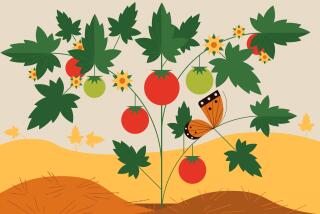Too hot to handle, so shop around
OTHER than watch the tomatoes grow, there’s not much to do in the July garden (except water, of course). It’s summer, it’s hot, it’s not a good time to start any projects, or to try planting anything new. This is no time to be digging big holes. Instead, make plans for fall, when the best gardening season gets underway. You can even shop for plants at nurseries, but if you purchase any, keep them in the cans until the weather cools (see below). Two places where you can safely plant, though, are in the shade and in water.
A home nursery
Do stop by a nursery to see what’s blooming. Some trees, shrubs and perennial plants only flower in the heat, so if you want summer blooms, you need to see and buy those plants now. But then wait for cooler weather to plant. In the meantime, keep them clustered in your own little nursery area, where they are easy to water. Choose a spot that gets strong light or even sun, but shade in the afternoon. Water them every day and fertilize once a month with a mild fertilizer, such as fish emulsion. You simply want to sustain the young plants, not encourage them to outgrow their nursery containers. In mid to late October, plant them in the garden. Next summer they’ll bloom again, at about the same time.
Temporary color
Nurseries also have blooming annuals and bedding plants, but even in beds that are watered automatically, the plants can be difficult to establish at this time of the year. Spring was the time to plant. Right now you could try bedding plants in big, easy-to-water pots for some quick, temporary color. Choose pots that are wide but not too deep since most bedding plants have shallow roots. Six to 8 inches is plenty deep, but pots can be as wide as you can lift. Put the pots in strategic spots and the whole garden will look colorful for those summer barbecues. You may have to water twice a day when it’s really toasty.
Wilting
On especially hot or dry days, plants in the ground or even in pots sometimes wilt when they cannot take up water fast enough -- like they were trying to slurp up a cold, thick milkshake through a small straw. Do nothing and the plants will recover when the sun drops a little. Mistakenly water a plant that has temporarily wilted and the already moist soil may become too wet and diseased. Before watering, push a screwdriver or your finger into the soil to see if it is wet or dry. You can safely mist wilted plants to cool them off, but just wet the foliage.
Water and weed
Watering is the crucial summer job. If it’s done automatically, make sure the sprinklers are all working and that they water early in the morning before the sun comes up or breezes start. Remember, the healthy way to water is to irrigate long enough so that water gets down to the roots where it is safe from evaporation (6 to 12 inches deep), but not too often so the soil has a chance to dry a little. Summer weeds sprout every time you water (one reason drip irrigation is a more effective way) so keep pulling or hoeing them out before they can set seed. Do it early in the morning for weeded plants to quickly wilt in the summer sun.
Tomato troubles
Tomato vines often stop producing fruit when the days and nights get too hot, but they will begin again as the weather cools. Watch for the giant green tomato hornworms (look for their droppings or make them wiggle by spritzing the bush). They must be handpicked. Also watch for the green, knife-edged keelbacked treehoppers, which suck juices from stems. Their young look quite different -- black and spiny. Spray with soap sprays or crush with gloved hands. If plants get diseases there’s not much you can do, though watering will often hasten their demise, so keep them on the dry side.






